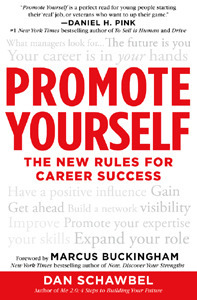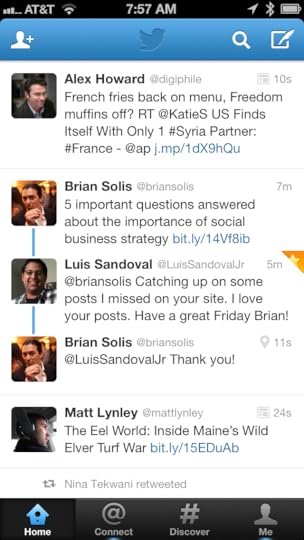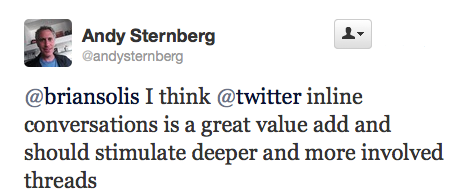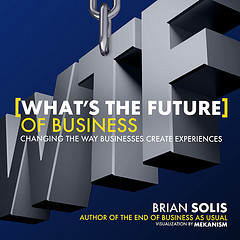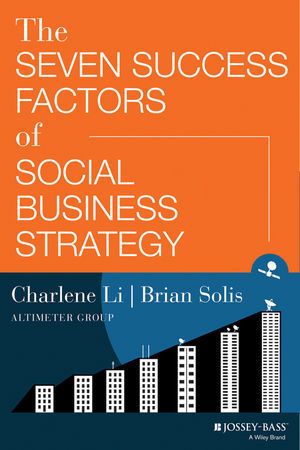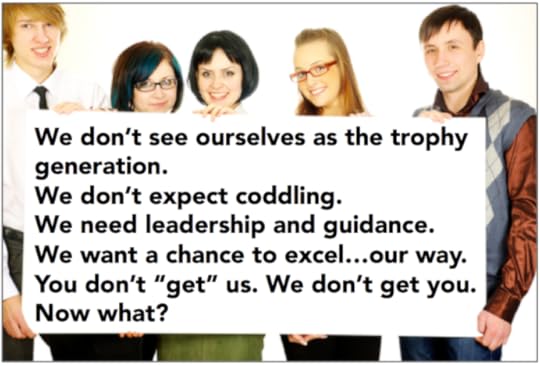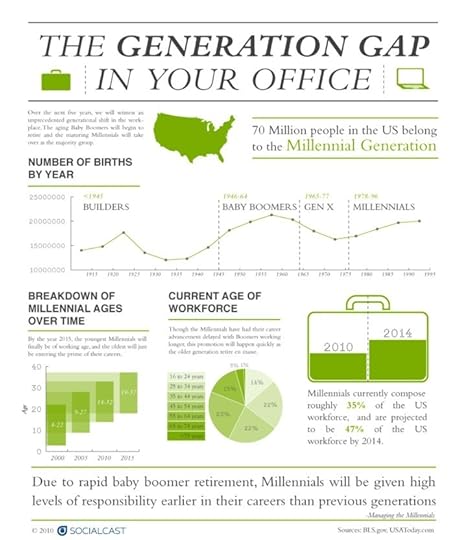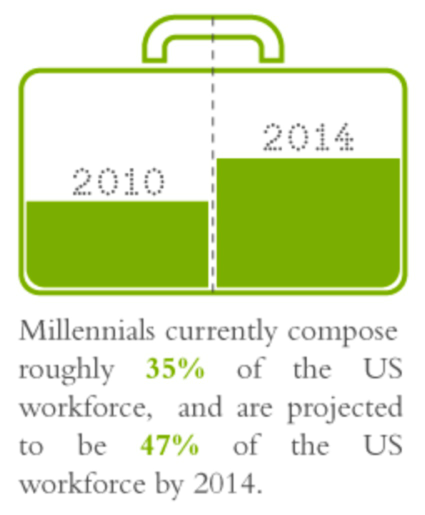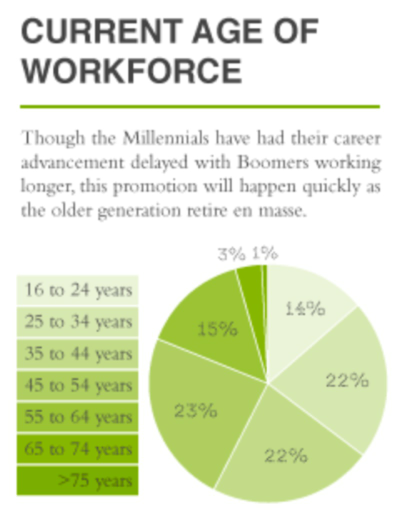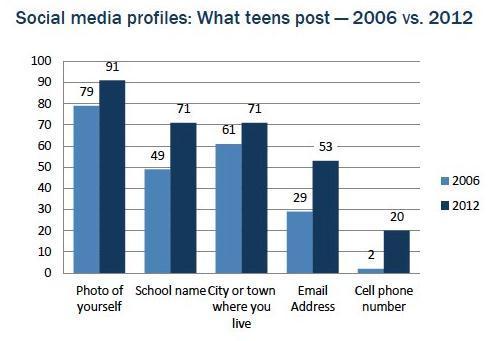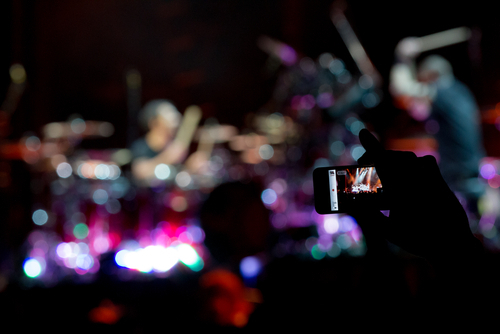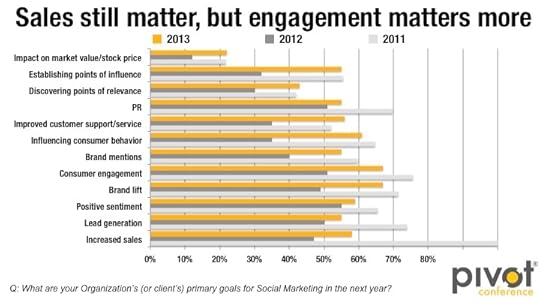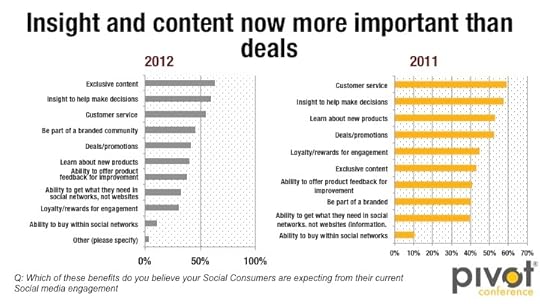Brian Solis's Blog, page 117
September 3, 2013
The Truth About How Social Media Has Impacted Employees
Guest post by Dan Schawbel (@DanSchawbel), a Gen Y career and workplace expert, the Founder of Millennial Branding and the author of the new book, Promote Yourself: The New Rules For Career Success (St. Martin’s Press).
Back in 2007, I created the first social media position at EMC Corporation, a Fortune 200 technology company based outside of Boston, MA. Back then, selling the idea of social to the company was extremely tough because it was so new, management was afraid and there was a lot of red tape. I would have to present case studies from competitors and partners to prove it’s worth, citing DELL and NetApp as examples. This is what most social media professionals had to do back then and now, since there are enough case studies, it’s less about the convincing and more about the doing. The one thing that doesn’t get discussed enough is how employees are using these tools to build their own careers at their companies. The research I did, in partnership with American Express, for my new book might surprise many of you.
Last year, we surveyed 1,000 millennial employees and 1,000 of their managers and we found that social media has still not been embraced and taken seriously in the workplace. Few managers and employees view social media skills as being important to their jobs and when it comes to promoting. Managers aren’t particularly comfortable connecting with their employees on social networks. When it comes to who owns an employee’s social media profile, many managers believed the company did instead of the employee. Here is a breakdown of the results from the study and what they mean to you and your job moving forward:
Do managers care about social media skills when promoting?
Relative to social skills (interpersonal skills) and hard skills (technical skills), social media skills are viewed as the least important at work. The value of social media in the workplace hasn’t been tapped by companies yet and few managers and employees put an emphasis on using social media tools for business related activities. That being said, employees have adopted social media tools for business slightly more than their managers. Only 16% of managers and 17% of employees view using social media profiles to actively contribute to online industry conversations as either very important or extremely important. Only 12% of managers and 17% of employees view using social media profiles to build a following on social networking sites as being very important or extremely important. 16% of managers and 19% of employees think that using social media profiles to promote their company is very important or extremely important.
I expect these numbers to grow in the future as the tools get adopted more and millennials become the majority of corporations. Millennials are constantly using these tools to build their own hard and soft skills and change the way business is being done.
What are social media relationships between managers and their employees really like?
The relationships managers have with their employees on social networks is shaky and uncomfortable based on this study. Overall, employees are more comfortable being friends with managers on social and professional networks than their managers are. When it comes to Facebook, only 14% of managers are either very comfortable or extremely comfortable being friends with employees, while 24% of employees said the same. When millennials become managers (15% of millennials are already managers), they will be more comfortable with social media relationships and view them as a way to build a network and drive business forward.
For the study, we also looked at managers searching for information about their employees online and the reactions to what they share. In every instance, more managers look up information about employees online than employees looking up information about their managers. Overall, both groups aren’t using the web to research for information on each other. When it comes to social networking sites (i.e. Facebook and Twitter), 81% of managers don’t look up information about their employees and 83% of employees don’t look up information about their managers. Out of those who said yes, more younger managers would look up an employee than older ones.
Managers and employees are careful when using social networks. Although you hear about those extreme cases of employees being fired for social media mishaps, they are rare. For instance, 88% of managers and 92% of employees haven’t noticed anything inappropriate and 91% of managers and 97% of employees haven’t spoken to the person misbehaving online. Only 4% of managers have disciplined an employee from what they’ve said online.
Managers and employees will continue to check up on each other online out of curiosity and for relationship building purposes. Obviously, common sense is important when you’re posting and sharing online because you are what you post. If you’re posting questionable things online, it will increasingly haunt you in the workplace because that information is just a click away.
Who really owns your social media profiles?
By now, you’ve probably heard about the PhoneDog vs. Noah Kravitz case in which PhoneDog felt that they owned Noah’s social media profiles. For the study, I was curious to find that many managers felt like his profiles should be given back to his employer. Millennial employees feel that they should own the rights to their own social media profiles even if they use them during work hours. Fewer managers agree that their employees should. Out of the managers, only 54% said that employees should have the rights to the profiles, yet 69% of employees said they should have them.
Social media profiles are sacred to millennial employees. They use their profiles to connect their personal and professional lives together and most log into them at least once per day. Instead of confiscating profiles, have social media guidelines and best practices so they know how to best use them to support the company. By encouraging social media use, you will attract and retain better Gen-Y talent.

August 30, 2013
Will Twitter’s New Conversations Hinder or Spark Conversations?
Twitter recently announced “Conversations,” a new feature that connects conversations via a blue vertical line. This new feature believe it or not has sparked a red line between love and hate. Ironically, this impassioned back-and-forth demonstrates the value of Conversations.
For years, Tweets appeared in a reverse chronological order. Now, you can see connected conversations in chronological order within your normal stream to follow real-time dialogue. To follow deeper threads, Twitter includes a clickable link to instantly “view replies.”
ABC News’ Technology Editor Joanna Stern reached out to talk about the controversial update. While some of my thoughts made the cut, I wanted to share the entire conversation with you here.
For years, one of the most common search phrases in Google for Twitter is, “What is Twitter.” To this day, mainstream has yet to truly understand what Twitter is and where it fits in the world of social networks. Is it a social network? Is it an information network? Is it a public IM stream? The answer is yes to all of the above. Conversations are as important to Twitter as #hashtags. This new feature allows you to not miss out on important dialogue. And, when you think about it, Conversations extend the 140 character limit allowing people to share their thoughts while tethering them in a coherent and sequential flow.
There’s more to the story as well. Twitter is setting the stage to take the company public. Investors expect a return. Employees expect earn out. To do so, Twitter will need to make engagement more intuitive for the masses. Tweets have been asynchronous to date. Adding a conversation feature does just that, promote conversations beyond one-off tweets. If the lifespan of a Tweet meme is minutes, conversations theoretically would introduce longevity into the mix thus keeping people engaged in micro conversations within the greater real-time conversation.
As for pushback, we’ll have to get used to it. Twitter is headed from Main St. to Wall St. sooner than later.
My new book…#WTF
Connect with me: Twitter | LinkedIn | Facebook | Google+ |Youtube | Instagram

August 26, 2013
5 important questions answered about the importance of social business strategy
Charlene and I recently published a report that documented the 6 Stages of Social Business Transformation. In the process, we discovered the most common mistakes and successes businesses experienced along their journey. What was most surprising however, not really, was the cavernous disconnect between social media strategy and overall business objectives.
- Only 34% of businesses feel that their social strategy is connected to business outcomes.
- Just 28% of companies we studied feel that they have a holistic approach to social media, where lines of business and business functions work together under a common vision.
- Only half said that top executives were “informed, engaged and aligned with their companies’ social strategy.”
The report was written to help strategists bridge the gap by understanding where they are, where they want to be, and how to get there efficiently. Charlene and I also noticed that the most elite companies among those we studied shared seven success factors in their social business strategy. Rather than publish a follow up report, we experimented with an ebook format. The result is a 100 page resource guide that will help you expedite and enhance your path to transformation.
As we were preparing for launch, our publishers, Josie Bass, asked an important question upon release of the ebook, “what does it really mean to be a social business and why is it important?” From there, it lead to an in-depth conversation where we answered a total of five questions designed to help you push forward when others push back.
Remember, informed and inspired persistence overcomes resistance.
What does it mean to be a social business?
A social business is more than social media and the Likes of Facebook, Twitter, Pinterest, et al. Yet, it’s a term that’s often confused with social media strategy. There’s an important difference between a social business and a social media strategy.
Each represent distinct qualities for which “social” is simply a qualifier. In front of media, social is an adjective that describes the nature of channels, networks, or platforms that facilitate conversations online. When placed ahead of business, social articulates a philosophy or approach.
In this case, “social business” is a philosophy, a way of business in which social technologies supported by new approaches facilitate a more open, engaged, and collaborative foundation for how we work.
How do you convince companies to see social media as more than just, “a necessary nuisance?”
The fact that social media and social business still cause debate or even confusion after all these years is understandable. Many executives see social media as a novelty or a distraction for young adults and kids. They haven’t realized the impact of social networks because they either don’t have time, can’t see the value, find it difficult to keep up with all of the networks, or a combination of all of the above.
Coming back to the differences between social media and social business, it’s important for any social media or digital strategist to learn the language of the C-Suite. In this ebook, we share insights from several top executives to understand what it takes to convince them of the true opportunity that social business promises. We’ve heard time and time again that their priority and focus is driving business objectives, creating opportunities, and solving problems. They don’t make decisions based on technology or trends, yet strategists tend to emphasize social media rather than business goals.
A social media strategy outlines how a business will employ social networks to engage customers or employees.
A social business strategy starts with a vision for how social media will improve customer and employee experiences and relationships and therefore aligns social media initiatives with business goals and opportunities. Technology thus becomes an enabler for a bigger mission and purpose.
Executives asked that we consider a day in their life. They report to stakeholders and sometimes shareholders. They are measured on business performance. If you do your homework to understand their priorities and align social with their business objectives, you’ll earn their attention. Add to that customer expectations, preferences, and the opportunities and challenges with each and how you can help solve against them. By presenting social in this light, executives can’t help but at least support further research and ultimately pilot programs that lead to bigger initiatives.
In the end, you learn that a true social business strategy employs social as one of the primary channels, not the only channel, to deliver a consistent, connected, and additive experience online, through mobile and in the real world by modernizing and improving the complete customer and employee lifecycle.
What are some criteria that organizations should use to prioritize their social initiatives?
As mentioned earlier, social media strategies are often sparked by technology or trends. I’ve heard strategists focus on Pinterest because of its popularity, not necessarily because there was a clear correlation between Pinterest users, behavior, and business opportunities. This is also true for most popular or emergent platforms.
When you begin with business objectives, social technology and the communities they reach are evaluated against bona fide priorities that already have the buy-in of executives. In this case, we look at business pillars to assess the criteria that contribute to the success of any organization, which can include sales, employee and customer satisfaction, brand resonance, NPS, etc. These pillars represent the primary measures for assessing value in the social business strategy process.
For example, each initiative should be assessed at the functional, line of business, or brand level. From there, ideas must tie value to the organization (business goals) and also consider the team’s ability to execute. Evaluating ideas this way helps prioritize opportunities while uncovering needs, training, support or assets required to properly execute.
How important is it to get the C-suite on board with social business strategy?
In our research, we learned that as social media permeates the enterprise, it typically does so from the marketing or communications department. Usually a social media champion rallies adoption within the organization. As social becomes more prevalent in society, more champions arise throughout the company, seeing it as an opportunity to improve how they do things today. As it gains momentum, it creates an internal groundswell that eventually requires budget, resources, training, and governance to support expansion and introduce enterprise-wide standards and goals.
At this point, social usually hits a ceiling that requires executive sponsorship to truly transform how a company views social’s potential. Anyone experienced in change management will understand that systemic transformation occurs from the top-down. Earning buy-in, making the case, tying strategies to business objectives, learning the language of the C-Suite – this is how strategists can earn support and bring about the change they wish to see. This is true for more than social media of course. But in that regard, getting the C-Suite on board is imperative to launching productive social business initiatives.
Why do you recommend a three-year plan? Is that realistic, considering the rate of technology change?
If there’s one thing we can bet on, it’s that change is not only necessary, it’s slow to appreciate and ultimately unfold. A three-year plan is far enough out to plot a course for transformation but also tangible in the sense that real programs can be deployed now and over time to the benefit of customers, employees and the bottom line.
Remember, social business isn’t about technology; it’s about attaining goals and objectives by improving relationships, driving transactions, and enhancing experiences through channels of relevance. Technology and channels will always evolve and as such, they become enablers for a higher purpose. This is about the ongoing pursuit of relevance.
Click the cover for more information on the ebook and also how Altimeter Group can help:
Connect with me: Twitter | LinkedIn | Facebook | Google+ |Youtube | Instagram

August 21, 2013
The Disconnect Between Aging Management and the Younger Workforce
Are you ready to connect your connected workforce?
With all of the discussions around social media and how it improves the opportunity to engage customers and build more meaningful relationships, we tend to lose sight of another important group…employees. As technology impacts behavior and connects customers and businesses in new ways, the same is true for employees.
With every new social and mobile network, every new smart device, and the materialization of trend after trend, people become increasingly informed, connected, empowered, and also demanding. As a result, businesses are making significant investments in new marketing technology to pursue and engage connected customers where their attention and time is focused. But these same connected customers are also your connected employees. And, how they’re expectations are evolving as well. These digital natives equally require engagement.
Before you can engage externally, you must first engage within.
The Generation Gap
Within your organization, a “C” change is developing, one that will transform the company from the inside out. This C change refers to connectedness as your connected employees will demand new processes and reward systems to satisfy their needs and motivate their professional development. Today, the balance between the generations within is tilted toward Boomers and Generation X. But, in just a few short years, the balance will shift to the Millennial (Generation Y) and how they communicate, collaborate, learn, and grow is much more digital than older demographics can appreciate. For the Millennial, digital is in their DNA.
To visualize the generation gap, ComplianceandSafety.com, a provider of training materials on workplace safety, released a telling infographic that tells a powerful story of the disruption that looms on the horizon.
As stated at the top of the image, “over the next five years businesses will witness an unprecedented generational shift in the workplace.” This will have an almost unfathomable impact on not just how the company operates, but also its operating philosophy and overall culture. If businesses don’t take a proactive approach to defining this over the next several years, it will be defined organically. And, it might not evolve according to a favorable vision and purpose.
Currently 70 million people in the US belong to the Millennial Generation. They represent 35% of the workforce today and by 2014, they will comprise of almost half of all employed professionals. In a separate study conducted by Millennial Branding, it is expected that by 2025, Generation Y will represent 75% of the workforce.
To say that businesses are in for a culture shock would b a gross understatement.
As the infographic notes, Millennials represent a surging eruption that will have a lasting effect on organizations almost over night. One of the factors leading up to this moment was quietly but valiantly influenced by the tumultuous economy that pulled U.S. consumers through a persistent recession. Boomers, unfortunately, were forced to delay retirement plans to regain losses to their financial nests and also invest in any potential catastrophic events that could re-appear. Now, as Boomers begin to retire en masse, Millennials will realize career advancement like no other generation before them.
As the infographic notes, Millennials will be given high levels of responsibility earlier in their careers than previous generations.
These employees are your new consumers. They are the face and voice to the company. They are your new ambassadors and what’s important to them requires study now. Ultimately the generation gap requires bridging led by those on either side of the gap. For the boomers and Generation X’ers who represent today’s decision makers and those Millennials who are on the rise, research and open dialogue will set the stage for the future of not just the workforce but the tone and culture of tomorrow’s business.
With the shift in generations comes a shift in value and values. Leadership is at risk of a great disconnect. Leaders will find their power lost if they cannot relate to this new generation and equally if Millennial s can’t relate to today’s leaders. Before a baton can be passed along it needs to mean something. It needs to symbolize the closing of the generation gap between employees and ultimately customers.
Conversations about the vision and purpose of an organization and how it relates to a rising generation of employees and customers cannot begin soon enough. At the same time, what must stop is any mindset or approach of “us versus them.” Complaining about Millennial behavior or expectations is met only by Millennial complaints about aging management. They’re different. Get over it. If you’re not building bridges your weakening the foundation upon which the future of your business sits.
You must take the first step.
The question to answer is what does your brand or mission mean to tomorrow’s customer or employee? How will they align with it and stand behind it?
This is an effort that’s far bigger than HR. This is a brewing groundswell that’s already impacting business from the bottom-up. Your mission now is to lead transformation from the top-down to meet in the magic middle.
My new book…#WTF
Connect with me: Twitter | LinkedIn | Facebook | Google+ |Youtube | Instagram

August 18, 2013
3 short videos on innovation, surviving conferences and cringe-worthy career moments
Every now and then, I take a step back away from research, writing and the relentless barrage of disruption and innovation to go through my inbox, favorites, bookmarks, etc., to see what’s worth revisiting. To my surprise, I’d forgotten about three fun, short 60-second videos that I shot for LinkedIn on location at SXSW 2013. While short, I was thoughtful in my responses to three important yet diverse questions. As such, I’m hoping that they might either help or entertain you – maybe both!
What is the most exciting innovation of 2013?
What is your best advice to survive a busy conference?
What was my most cringe-worthy career moment?
Enjoy!
My new book…#WTF
Connect with me: Twitter | LinkedIn | Facebook | Google+ |Youtube | Instagram

August 13, 2013
Broadcast Yourselfie: How teens use social media and why it matters to you
If you want to know the future of technology and its impact on society study how younger generations interact with one another today. With the sting of a face palm, you’ll experience a sheer rush of humility as you realize that everything you thought you knew about tech is simply nascent compared to the sophistication of digital natives. No matter how connected you are or how many followers or friends you have online, there’s a sense of artistry mashed together with counter intuitive behavior that just works.
My advice to you is to study it.right.now. Don’t try to make sense oft it? Don’t question it. Don’t try to make it fit into your world. Simply try to understand it. Doing so opens the door to meaningful insights. And, this allows you to make decisions about the future without letting your predispositions or assumptions lead you in fallacious directions.
To help Pew Research Center published a new study that examines teens’ social media privacy management and overall behavior. Why is it important? Well, for starters, social and mobile for teens (aka digital natives) is simply a way of life.
A Crazy Little Thing Called Privacy
If you think about it, Generation X and to some extent the older side of Generation Y, are the last to know privacy as it was. Privacy for the most part is something that older generations guarded. For most, privacy was and is sacred, worthy of protecting. Publicity on the other hand was almost a luxury. To earn the attention of the masses required investment and strategy. It’s almost the opposite is true among digital natives. Privacy now is something that you have to teach or learn the hard way.
According to Pew, teens share more information about themselves on social media than ever before.
91% post a photo of themselves, up from 79% in 2006.
71% post their school name, up from 49%.
71% post the city or town where they live, up from 61%.
53% post their email address, up from 29%.
20% post their cell phone number, up from 2%.
While the top three aren’t necessarily jaw dropping, we start to see the erosion of privacy and the rise of publicness with the jump in sharing phone numbers publicly. And this is only the beginning.
Pew Data Visualized: Source: MarktingLand
Once regulated to closed networks and dedicated communities for school, work, dating, etc. personal information is now finding its way into public spaces such as Facebook, Twitter, et al.
92% of teens post their real name to the profile they use most often.
84% post their interests, such as movies, music, or books they like.
82% post their birth date.
62% post their relationship status.
24% post videos of themselves.
Privacy takes on an entirely new meaning now. While much of social and mobile is often studied through the lens of what people say and share and what they don’t, it’s also tied to movement (GPS), transactional data, and specific locations. In fact, Pew learned that 16% of teens have set up their social profiles to automatically include their location in posts. Doing so sends a passport-like signal to their friends (and for themselves_ about where they’ve visited combined with a sense of serendipity to also see (and meet) who’s nearby.
A Private Facebook vs. A Public Twitter
94% of all teens who use social media have a profile on Facebook. Twitter’s rising fast. 26% of teens manage a profile on Twitter, which is up from 12% just one year earlier.
On Facebook, ironically enough, teens tend to choose a myriad of privacy settings. 60% keep their profiles private and most believe that they are in control of their privacy settings. They also go through hoops to support multiple accounts to engage on respective fronts accordingly. They also go to great lengths to delete older posts to prevent the risk of future drama.
With Twitter on the other hand, 64% of teens choose a public profile and 12%, believe it or not, are not sure whether or not their public tweets are private or public.
The Brand “You”
Teens, in their own way, manage their Facebook presence to portray their desired persona while masking information they don’t want others to know or learn.
On Facebook, teens host a network of 300 friends on average. On the more public Twitter front, average teen users have about 79 followers. This comes down to an important distinction about the value and focus of each network. Facebook is designed to help people connect and communicate to their social graph. With Twitter, it’s all about the interest graph. People tend to follow others who share interests or channels that are informative and entertaining, not unlike a traditional broadcast network.
The Age of the Selfie and The Rise of Accidental Narcissism
What’s not included in this study is how teens use Tumblr, Instagram and Snapchat. This is a critical element missing from the study. While an overwhelming majority of teens use or have Facebook accounts, teens, and millennials in general, are spending significant portions of time and attention in other networks such as Tumblr (a social network for micro content), Instagram (a social network for pictures) and Youtube (a social network for video), SnapChat ( a network for self-destructing pictures). See the pattern?
Why?
In an interview with AP, Jaime Esquivel, a 16-year-old junior at C.D. Hylton High School in Woodbridge, Va., shared a truism that I’ve heard repeatedly among teens over the years, “Facebook just really seems to have more drama.”
But it’s more than that. Other networks seem to focus on curated content and also self-expression.
Instagram is not just a camera app, although many younger kids fooled their parents by convincing them that it was a camera app. Instead, it’s a full blown social network where pictures of the catalysts for conversations and Likes and followers are the currency of shallow capitalism. Instagram is harboring curious behavior where teens strive for numbers, regardless of where and who they come from, as a delusional form of stature and importance.
In a study in Photo District News, author Kathleen Hay shared some sobering stats on the rise selfie-expression.
At 11 p.m. PST on December 28, 2012, the number of selfies numbered at a noteworthy 5.5 million. At the same time, photos tagged ‘me’ completely eclipsed “selfie” with a staggering 72.6 million self-portraits. Added together, you start to get the picture of just how prominent the egosystem is becoming.
Privacy as we once knew it is dead. It’s now a part of real and digital life that necessitates education and ongoing study. Parents, teachers, mentors, role models, take note. Pleading ignorance is not an excuse.
For adults, privacy’s meaning is also shifting. To evolve, a new school of philosophy and overall strategy is essential as we use the same apps, networks, and devices that younger generations use to broadcast their social life. The line that divides online and offline character and image is rapidly, and intentionally, eroding. And for some, it’s completely vanished.
In many ways, we are all exhibiting behaviors that aren’t unlike teens, regardless of age. The truth is that we live in an era of increasing connectedness and we are all becoming part of one larger generation, Generation-C (connected.)
Welcome to the new age.
Connect with me: Twitter | LinkedIn | Facebook | Google+ |Youtube | Instagram
Image Credit: Shutterstock

August 7, 2013
The Accidental Narcissist And The Future Of [Connected] Customer Engagement
Have you ever noticed that your Facebook News Feed is the digital equivalent to “It’s a Wonderful Life?” Perhaps you’ve likened your Instagram stream to that of “Lifestyles of the Digital Rich and Internet Famous.”
In each network, and across multiple social streams, you’re fed a visual buffet of seflies, travel, food, fashion, and celebrations. In assemblage, they tell the story of life well lived, or at least a life well curated. At the center of each of these experiences is the person living and sharing them in real time. Every day that passes, it seems that a growing network of our friends, family, and colleagues are charmed with this picturesque life.
Some may see this behavior as self-centered, self-promotional, or view it as a form of attention seeking, but at a human level, it’s simply a new form of self-expression and an open invitation to interact.
But who are we kidding? It’s not just everyone else, we might as well be talking about ourselves. It’s a social world after all and shared experiences are the epicenter of a growing majority of engagement. As such, we’re introduced to a new law of social physics, if you will, where for every action there is an equal or greater reaction. The truth is that social sharing is part self-expression and also part provocation. People share to communicate who they are or who they want to be, while concurrently hoping to incite a reaction that validates or substantiates their intended online persona.
This phenomenon may seem like a personal discussion, but I can assure you that it has everything to do with your business.
I’d like to officially introduce you to your connected customer. I believe it’s about time we get to know the connected set to better understand how to engage them in social and mobile networks now and throughout the entire customer lifecycle.
It’s all about you and me…but mostly me
If you’re reading this, then you’re most likely the very person you’re trying to reach. You’re connected, always on, unabashedly multitasking, and living across multiple screens each and every day. You live a digital lifestyle and without realizing it, you and others like you, are gradually exhibiting slivers of narcissism. Believe me, I say this with the utmost discretion. You can’t help it of course. These networks prompt you to share your world, your way, all day, every day. And each time we do, we contribute to our “egosystem,” where we are the center of our own digital universe. Experiences and engagement represent the orbits that bring us together.
Let’s visit planet Facebook and its orbiting moon Instagram for a moment. Facebook is now home to over one billion digital denizens. To put that in perspective, that’s roughly about 12 percent of planet Earth. Instagram is a fledgling digital society in its own right. At 100 million residents and counting, a culture of sharing one’s experiences is further enhanced by the ability to instantly enhance them with a creative filter, broadcast them across multiple networks, and earn the attention and reaction of a boundless and seemingly idle audience.
The question is, if everyone is busy sharing content, then who is consuming it? This is also the law of social attraction. It’s a reciprocal relationship where to earn reactions, one must equally or progressively react. How do you do that if the real-time web moves in real-time?
The age of prevalence
Understanding digital behavior has never known greater importance. As it evolves, we need to appreciate its velocity and impact. For example, on Facebook, conversations lose momentum in an hour, give or take. The reason for this is because people consume until they create. As they create, expectations shift as characteristics of narcissism take over. What about Instagram? Allow me to share some revealing behavioral stats that will make you say “Wow.”
Statigram is a third-party tool that tracks activity on Instagram. According to a fascinating article in pdn (Photo District News) written by Kathleen Hay, Statigram tracked the number of photos tagged “selfie,” social slang for self-portrait (yes, that’s a thing.) At 11 p.m. PST on December 28, 2012, the number of selfies numbered at a noteworthy 5.5 million. The egosystem wouldn’t be the same without the “me” in social media. At the same time, photos tagged ‘me’ completely eclipsed “selfie” with a staggering 72.6 million self-portraits. Added together, you start to get the picture of just how prominent the egosystem is becoming.
In the article, Hay introduces us to Dr. Jean M. Twenge, Ph.D. Professor of Psychology and author of Generation Me and co-author of The Narcissism Epidemic: Living in the Age of Entitlement. The titles alone convey that connected consumerism is nothing like the conventional customers you once knew. To better understand the crux of selfies and the digital “me,” Twenge explains that at the core of narcissism is this invention or aspiration that people are better or more important than in reality. In the digital realm however, perception is reality.
Agree or disagree, this is your connected customer. And in many ways, you and those you know are among them.
How can you re-imagine your engagement strategies to align with and inspire the “me” in social media? How does — or how can — your brand evoke an experience that elicits self-expression? And how will your brand become part of the egosystem and create a gravitational pull for others to orbit?
Connect with me: Twitter | LinkedIn | Facebook | Google+ |Youtube | Instagram

July 30, 2013
Is Freedom of Tweet a Right or a Wrong?
Twitter and Facebook are under fire for the role each platform plays in unknowingly tolerating flagrant hate-fueled, public-facing obscenity and outright threats. Twitter was targeted as the result of an advocate for honoring women on British currency was deluged with sickening rape threats. Facebook too has been criticized for its molasses-like pace for contending with hate posts and groups. In the case of Twitter, its UK branch reaffirmed its position against hate by publishing a post that acknowledged complaints and also introduced new mechanisms for flagging offending posts.
When my friend Doug Gross at CNN reached out for comment on whether or not Twitter, Facebook and social networks as a whole were doing enough to protect users, I had to speak up. With such a charged and important topic, I couldn’t however speak in traditional media-friendly sound bites. Here’s what I had to say…
Expressed hate and abuse is unfortunately part of our society and it is now also part of our real-time digital culture. As we live the digital lifestyle, our expectations are such that any menace should not only be dealt with accordingly, it should be done immediately. Twitter represents a new medium that the world hasn’t seen before. To protect its users, it must invest in automated and manual safety and reporting mechanisms as it grows. Believe it or not, the company is also ensuring the overall operation of its platform supporting 400 million Tweets per day.
At the same time, as users, we have a responsibility to learn what a Tweet actually means. The idea of “freedom of Tweet” does not supersede law. Expression aimed at hurting or threatening someone is indeed a threat heard around the world. Could Twitter do more? Of course. Removing Tweets, listening to users, and working with enforcement officials will curb this negative behavior, or at least provide a system for recognized consequences. It will not eliminate “hate” altogether as that is a regrettable function of our society. And, Twitter itself is its own digital society. As such, protection and a form of empowered “neighborhood watch”groups will be necessary to protect and serve Twitter’s denizens.
What are your thoughts? What else should Twitter, Facebook and the like (and you and me) do to improve the egosystem?
Connect with me: Twitter | LinkedIn | Facebook | Google+ |Youtube | Instagram
Image Credit: Shutterstock

July 22, 2013
STUDY: Social Business Strategy – Vision, Purpose and Value drive a new era of digital engagement
In an era when media is largely created and broadcast by the few to the many, social media emerged to facilitate the co-creation of media in addition to creating it. While difficult to trace its origins, the philosophy of social media dates back to the mid-1990s. It wasn’t until the mid 2000s however, that businesses would encounter the idea of a new medium where brand democracy prevailed over brand dictatorship.
Suddenly the voice of the customer took on an entirely new meaning and the promise of customer-centricity and engagement was thrust into the spotlight. But after all these years, businesses remain confounded. Even though most are experimenting with social media, how it improves relationships while impacting important business metrics is persistently elusive.
Here we are in 2013, firmly planted in the notion that social media is critical to business and customer relationships. Yet, experts to this day wrestle with the ability to tether intuition with data and creativity with business acumen. [See The 7 Success Factors of Social Business Strategy.]
In a connected economy where information becomes a powerful currency, social data will only help you benchmark where you are to help visualize where you could be. The relationship between aspiration and reality now become a more informed set of goals and objectives driven by benchmarking against the industry and more importantly, benchmarking against possibilities.
Each year, the Pivot team studies the evolving social landscape. For our 2012 -2013, “State of Social Marketing” report, we surveyed 181 social marketers and digital strategists who represent agencies and brands. What we learned is that the fundamental drivers for social media have radically transformed.
What’s clear however is that social media and the allure of conversations matter. At the top of the list, brands and marketers agree that conversations lift both brand and relevance. It’s the new stimulus and relevance is appropriate to the matter at hand.
When asked of the benefits for social media, 2013 goals largely matched 2011 expectations with the exception of sales and lead generation.
As you can see, primary goals fluctuated over the years, shifting toward a more customer-centric approach. Customer engagement, awareness, influence, satisfaction, and service top 2013 social goals whereas sales was off the charts in 2011.
Over the years, social marketers took a publish first ask second approach in social strategies. Assumptions outweighed intelligence. But in 2012, businesses started to realign customer expectations with social media strategies. In 2013 planning, social strategists now believe exclusive content is more important than customer service (2011).
The Top 10 Assumptions of Social Consumer Expectations
Exclusive content
Insight to make decisions (Moments of Truth)
Customer service
Be part of a community
Deals/Promotions
Learn about new products
Ability to provide feedback for improvement (Influence Loop)
Inclusive experience in social absent of websites
Loyalty/Rewards for engagement
Social commerce
So if we know social is important, what’s holding social marketers back this year? Planning for 2013 based on 2012 and 2011 hurdles remain close to constant.
Top 7 Planning Hurdles for 2013
Budget
A clear vision on outcomes
Executive skepticism
Lack of metrics
Lack of understanding of benefits
Lack of cross functional support
Absence of vision and overall strategy for the brand
Part of the planning challenges reflects a fire, ready, aim as opposed to a ready, aim, fire philosophy around social media. Planning is often campaign or engagement centric without a deeper understanding of needs, expectations and of course customer behavior. Even in the absence of clear and present business objectives and outcomes, executive buy in has risen.
In 2013, businesses will evolve from a more skeptical or cautious view of social into something that explores rhyme, rhythm, and reason.
The lineup of usual suspects in social media hasn’t changed much in the last year with the exception of Pinterest rising into the fourth spot in the top 5 social networks brands are paying attention to. This move comes at the expense of Google+.
How will organizations measure social media success in 2013? The answer is engagement.
Social media however is only part of a larger digital movement that’s impacting business from the inside out and the bottom up. This is perhaps the most important part of this study and here it is buried. Regardless of your opinion regarding the word “digital,” the bigger trend is digital’s disruption on business and overall consumerism. When asked what keeps marketers up at night, the list was great.
At the top of the list was the mobile experience. At the core however, every trend was related to customer engagement across all channels. I dare not say omnichannel as that assumes a one-size-fits-all mentality. Channels and screens relate to the context of the individual within the dynamic customer journey. As such, those trends that scored “5s” signify the great impact of digital disruption.
Top 10 Disruptive Digital Trends
Mobile experience
Content management
Digital customer experience (The Experience)
Brand journalism
New metrics/ROI
Integrated experiences
Business intelligence
Big data
Social CRM
Social media optimization
A prescient pillar of leadership takes more than intuition. It takes research balanced with a human algorithm. You can’t make decisions about technology and behavior if you are not part of the very culture that’s disrupting your business. Nor can you open engaging touch points if you’re unfamiliar with the new journey of decision-making. Yet even today, businesses are largely making assumptions based not on the expectations or behavior of customers but instead the best practices of their peers.
In 2011, 77% of brands believed they understood their social customers, yet only 35% did the work to better understand them.
In 2012, the number of businesses that had a clear picture of their social customers dropped to 62%
In 2011 and 2012 businesses largely ignored their customer’s digital needs and actions with 53% and 54% respectively not attempting to explore the differences between what they think they want and what they really want.
When in Doubt…Begin!
Charlene Li and I published an Altimeter Group report earlier this year that found businesses simply weren’t aligning business goals with social media objectives. To realize the promise the promise of social media however, strategists will have to make the effort to demonstrate business value, consumer trends, and the ability to use disruptive technology to disrupt competition rather than be disrupted by it.
This year, realize that your greatest assets are both humility and aspiration. Your ability to see things differently will in fact drive you to do things differently. By applying a new philosophy and methodology to your digital approach will naturally make your business and your overall strategy…meaningful and social. This is after all, about experiences now more than ever.
Benchmark against best in class, not just the competition
Research customer behavior and expectations
Consider existing and potentially new business objectives – align business and digital strategies accordingly
Apply needs and expectations within engagement and content strategies
Design dedicated yet united experiences across digital channels considering the context of behavior within each screen
Create a path of least resistance that maximizes the capabilities of each platform and screen
Re-imagine your vision and value for how disruptive technology enables a more meaningful mission and purpose
Embrace data science and digital anthropology to stay ahead of customer trends and the competition
Plug in to your customer experience as it exists and uncover points of friction…then fix it to provide a seamless journey from the inside out
10. Listen. Learn. Engage. Adapt.
Join us at the Pivot Conference this year in New York on October 15th and 16th
The State of Social Marketing 2012-2013 – Pivot Conference from Brian Solis

July 18, 2013
Self-Serve Information: Now, We’re All Passive-Aggressive
Guest Post by Jay Baer, a hype-free social media and content strategist & speaker, and author of Youtility: Why Smart Marketing is About Help not Hype. Jay is the founder of http://convinceandconvert.com and host of the Social Pros podcast.
One of the most interesting dynamics of the recent huge shifts in consumer behavior is that we need more information, but far fewer transactions involve face-to-face interactions with other people. This truly is the era of self-serve information.
How many times have you purposefully chosen to not fill out a contact form on a website because you didn’t want to be called, or even emailed? I’ll bet more than a few times. Even if it’s a product in which you have a genuine interest, you’ll avoid filling out that form until the last possible moment, preferring instead to kick the informational tires yourself.
”Smartphone” is a misnomer. We’re not using them to make phone calls. A decade ago I easily received 20 or more calls per day. Now, it’s three or four. Instead, I have a menagerie of inboxes, with asynchronous messages streamed to me from email, Facebook, Twitter, Linkedin, Pinterest, Instagram, my blog and text messages, as well as notifications from topic-specific websites like TripAdvisor.com. No wonder we want our information to be self-serve. We just want to be left alone!
Usage data proves this point. From 2009 to 2011 American females’ use of voice minutes on mobile phones decreased by 12%. During the same period their text messages sent and received increased by 35%. For men, it increased 44%.
And, if middle-aged men like me are going the passive-aggressive, self-serve route, imagine the behavior pattern of tomorrow’s dominant consumer cohorts? As chronicled on this blog by Brian Solis, new media pundit and author of What’s the Future of Business?, Sitel and TNS released research in 2012 that determined that 71% of U.K. residents between the ages of 16 and 24 will search for a solution online before contacting a company directly.
Generational marketing consultant Kelly McDonald, author of How to Market to People Not Like You, believes the impact of mobile Internet is, if anything, being underreported because of the propensity to use average figures to explain the trend. Averages include the mobile Internet usage of people who may never fully embrace it, such as her mother.
“My mom is 76,” McDonald says. “It’s not that she’s a technophobe, but she’s never going to be as comfortable with technology as someone who has not had to adapt to it, who has had it all their lives. Before the Internet, the greatest invention was electricity, but I grew up with it, so I don’t appreciate it. I flip the lights on, and they come on. But there was a time when electricity was amazing and awe-inspiring, and it made everything more efficient. So in the same way that our generation takes electricity for granted, younger people today take the Internet for granted, and because they grew up with it, they have no reason to not trust the information they find there. But my mom does not trust it. She doesn’t know if her mobile deposit ‘went through.’ She’d rather go to the branch and see them in-person.”
Death of the Salesmen
We used to talk to a real person as a first step. To get familiar with the company. To learn more. To create bonds. Not now. Now we talk to a real person as a last resort when we’ve exhausted the supply of Zero Moments of Truth (in the parlance of Google’s book by the same name that Brian also discussed in WTF) and have a query so specific only a human being can answer it.
This is most egregiously true in a category where the transactional stakes are often the highest: business to business marketing. In 2011 the Corporate Executive Board surveyed 1,900 B2B customers to uncover insights about purchasing behavior and found that customers will contact a sales rep only after independently completing 60% of the purchasing decision process. Sixty percent of the decision is made before the prospect identifies himself. Sixty percent of the decision is made before a call, or an email, or an entry into your lead tracking database. Customers are ninjas now. They are stealthily evaluating you right under your nose.
This has manifest consequences on the role of salespeople, whose job used to be to develop and nurture relationships. No longer. The role of the salesperson is now to answer specific questions capably and quickly, and to close deals that became possible due to the self-serve research performed by the customer. What does that 60% figure mean for marketers? A lot, according to the Corporate Executive Board’s Ana Lapter.
“The 60% mark is in that part of the mid-funnel that is critical in terms of driving the buyers’ consideration of a supplier for a potential purchase,” Lapter says. “Therefore, marketing needs to de-emphasize tasks like thought leadership and white papers, and focus more on advanced activities, such as diagnosing purchasing needs and identifying internal barriers to purchase.”
Marketing needs less top of mind awareness and more Youtility. Sounds about right to me.
Youtility Excerpt:
Youtility: Why Smart Marketing is About Help not Hype – Exclusive Free Excerpt from Jay Baer
Youtility Trailer:


